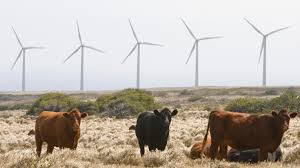 |
| Reviews and Templates for Expression We |
NZ renewables power on, but emissions a problem

One saves emissions, the others create them
While Australia’s Abbott Government is expected to wind back the country’s renewable energy target of 20 percent by 2020, New Zealand is pushing ahead with bi-partisan support for its own target of generating 90 percent of its power from renewables by 2025.
None of the parties contesting the NZ election, due on September 20, have challenged the NZ RET, although carbon emissions from subsidised agricultural industry – such as the expanding dairy industry – has put wider emissions’ policy on the agenda.
According to recent figures from the NZ Ministry of Business Innovation and Employment, renewables generated 79 percent of the country’s power in the three months to March 2014.
Due to its reliance on hydro electricity, NZ has always enjoyed a high percentage of renewables in its mix, but new forms of renewable energy are continually being installed. At one time, hydro comprised around 70 percent of NZ’s power but that is now down to around 53 percent.
Much of the push comes from new wind farms. The country currently has 19 wind farms producing 623 megawatts of power, or around 5 percent of total annual generation, but the industry has plans to push that to 20 percent by 2030.
The latest addition is Meridian Energy’s Mill Creek project, near Welllington, where 26 turbines provide enough power for around 30,000 homes.
Geothermal energy provides around 15 percent of NZ’s power, with the latest addition being the 159mW Te Mihi plant built for Contact Energy and opened in August.
There are still obstacles and issues around the target in NZ, however. Demand for electricity is flat, which discourages new projects. Mill Creek could be the last wind farm built in NZ for some time.
Despite this, a lobby group called Generation Zero has challenged whatever Government is elected this month to adopt a policy for the country to have 100 percent renewable energy by 2050.
The debate in NZ, however, is currently more about carbon and emissions with the Green Party proposing a carbon tax.
Due to its reliance on agriculture, NZ’s carbon emissions are rising, and are estimated to be double 1990 levels by next year and the country has the fifth highest emissions per head among among 41 developed economies.
The National Party government has set a biding target to cut carbon emission by 50 percent of 1990 levels by 2050, and the main policy tool for this is the Emissions Trading Scheme introduced in 2008.
Excising agricultural industries from the scheme, which are responsible for nearly half of NZ’s emissions, makes moving to this target increasingly difficult.
|
|
|
|
Copyright 2011 Energy and Technical Services Ltd. All Rights Reserved. Energyts.com |